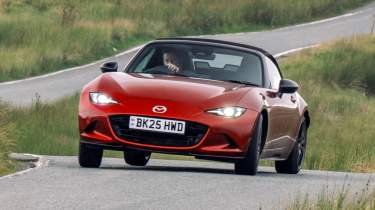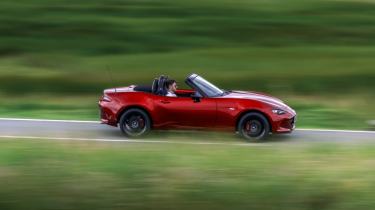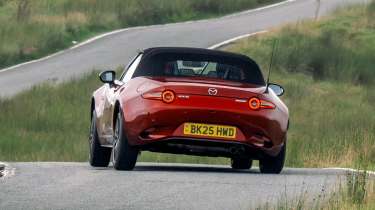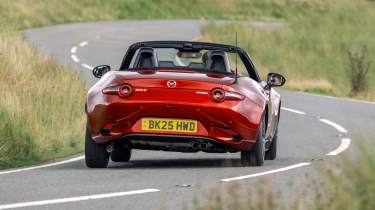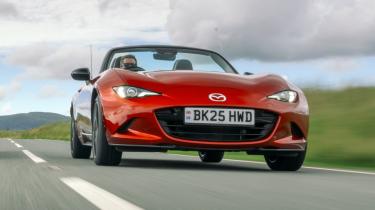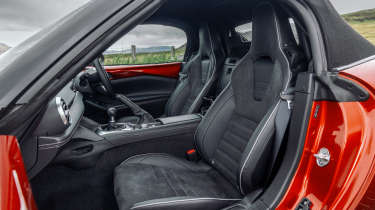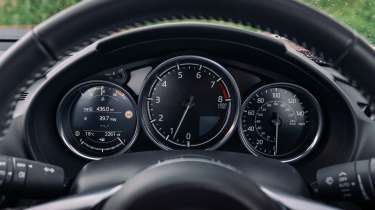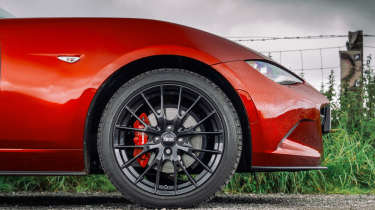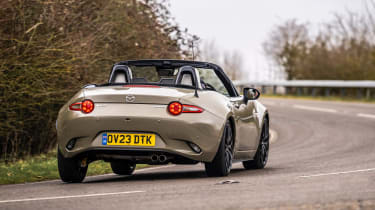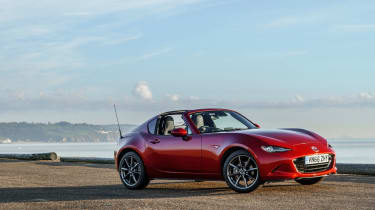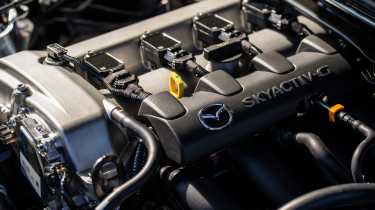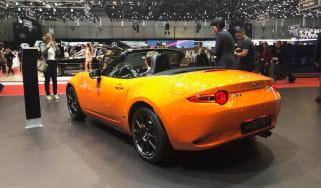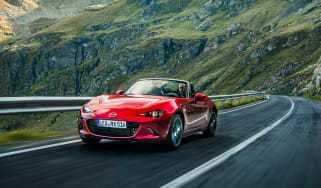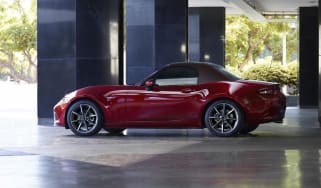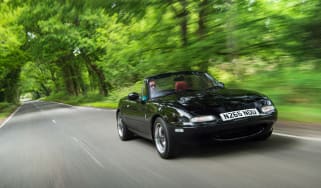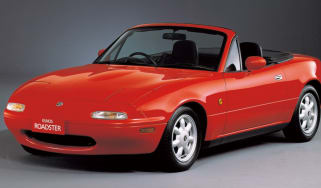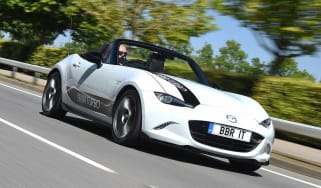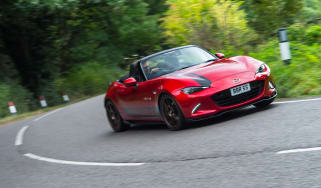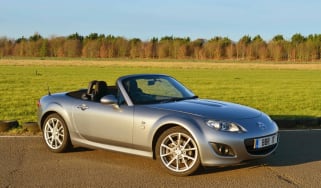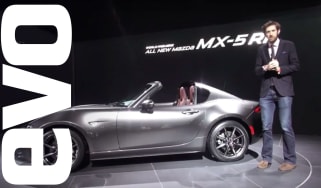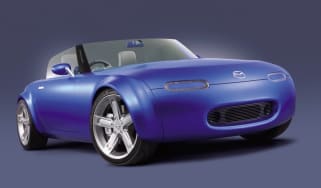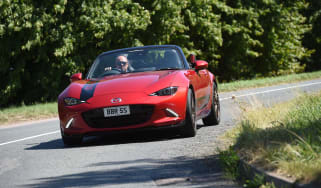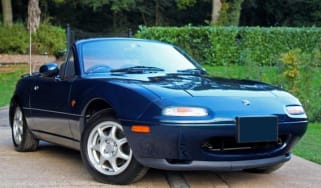Mazda MX-5 review – Japan’s lightweight sports car icon endures
That the MX-5 still exists in today’s era of huge, heavy electrified cars is a miracle. That it’s better than ever is the cherry on the cake
Is the Mazda MX-5 one of the only new cars that’s gotten better with age, despite very little changing about it? Now as in 2015 when the ND launched and indeed, in 1990 when the first-generation MX-5 first hit UK roads, it is a tiny, lightweight, two-seat roadster with a naturally-aspirated engine sending modest rotational force to the rear wheels via a manual transmission. In years gone by it’s been taken for granted as the perpetual starter sports car.
In 2025 it’s a delicacy to savour, an almost vital pallet cleanser for any road tester seeking perspective in a car market dominated by ballooning footprints and kerb weights. It’s a last bastion of the core tenets that we know breed great driver’s cars, as seemingly all others spiral out of control in the wrong direction. While what hasn’t changed certainly informs that status, what has – the new revised differential and steering – elevated the decade-old ND to eCoty podium-sitting heights. What a great car that we’re lucky to still be able to buy in 2025.
History
The MX-5 is one of the best-selling sports cars of all time, evolving incrementally in its 35 years but rarely at the expense of its core ethos of simplicity and light weight. MX-5s are long-lived, too, with only four generations spanning its tenure, the NA running from 1990 to 1998, the NB running frim 1998 to 2005, the NC running from 2005 to 2015 and the ND carrying on the lineage from 2015 to date.
More reviews
Group tests
Review
Reviews
- Performance Link Mazda MX-5 R300 review – an MX-5 with Honda VTEC power
- Mazda MX-5 RF 2025 review – evo Car of the Year 2024’s people’s champion
- BBR Supercharged Mazda MX-5 (NC) 2022 review – frenzied, affordable fun
- Mazda MX-5 R Sport 2020 review – floats like a butterfly, but stings like one too
- BBR Super 225 Mazda MX-5 review
- BBR Super 220 review - modded Mazda MX-5 hits with a light touch
Indeed the fourth-generation ‘ND’ is approaching its tenth year on sale but a facelift has given it a refreshed look, an updated cabin, revised mechanicals and electronics, and crucially, negligible weight gain. In the 35 years since it launched, the MX-5 has gone up in kerb weight by less than 100kg. By contrast, a 1989 BMW M5 is some 700kg lighter than its modern day equivalent.
While the 2-litre version was undoubtedly the quicker of the two engines available from launch, the 1.5 was the more engaging drive due to the free-revving nature of its engine. In the latter part of 2018, heavily revised engines came on stream, and the 2-litre now developed more power and was much sweeter than its earlier incarnation. The larger-engined models also receive a limited-slip differential and Sport models are the most driver focused thanks to Bilstein dampers, although the raspier and more compliant 1.5-litre version plays to the car's natural strengths well.
For those who insist on a tin-top there is also the MX-5 RF with its electric folding targa-style roof, which adds the looks of a coupe and some semi-exotic buttresses but retains many of the roadster’s attributes and quirks.
Engine, gearbox and technical highlights
- 1.5-litre and 2-litre engines
- Asymmetric limited-slip differential for the 2-litre
- Still a compact and lightweight
The 1.5-litre motor weighs 14kg less than the 1.8 MZR that powered the old Mk3. While also used in the (now discontinued) Mazda 2, for the MX-5 it features revised cam timing, lighter rotating parts, a custom steel crankshaft and new intake and exhaust systems, while retaining a 4-2-1 exhaust manifold.
The 1.5-litre MX-5s dip under the magic ton at 975kg without a driver (2-litre cars weigh an extra 55kg). With peak power of 129bhp generated at 7000rpm, it’s obvious that this engine will need to be worked hard. And so it proves, but as long as your performance expectations aren’t set too high it has plenty of appeal, with an effervescent character and a sweeter rasping note than the 2-litre.
The current 2-litre underwent a substantial update on the previous unit, with a nuanced and technical approach, such as delicate weight savings to the pistons and conrods, revised camshafts, exhaust valves, injectors, throttle valves and a new intake.
Both engines share the same six-speed manual transmission, which has a wonderfully short, mechanical action. Directly poking straight out of the transmission, there’s an acute physical connection between the gearbox and your left hand, passing through vibrations and movements as the whole powertrain wobbles on its mountings.
The range-topping MX-5 is the Homura, complete with Bilstein dampers and a new asymmetric limited-slip differential. This features a cam mechanism on the conical clutch that varies limiting force depending on whether the car is accelerating or decelerating. The steering has also been revised for improved feel and reduced friction too.
Power, torque and 0-62mph
The 2-litre now has some of the 1.5’s crisp response and willingness to rev (the redline is 500rpm higher than before), as well as a more substantial 181bhp power output.
The extra performance available in the 2-litre is notable in feel and on paper. It reaches 62mph in 6.5sec, a 0.4sec improvement over the previous 2-litre model. As well as the extra 500rpm, the updated 2-litre is an eager, rev-happy mill, even if it lacks the hard-hitting top-end punch of a VTEC.
> Toyota GT86 v GR86: how Toyota perfected the affordable sports car
It sounds good too, with a twin-cam naturally aspirated engine note so sorely missed in many of today’s performance models. The low weight of the MX-5 helps to offset the rather effete 111lb ft of torque the 1.5 delivers, generated at a lofty 4800rpm. Fully deployed it dismisses the 0-62mph sprint in 8.3sec, while top speed is 127mph.
Being heavier it’s no surprise the RF is marginally slower than the soft-top version. The extra 40kg that the 1.5 RF carries around means that it accelerates from 0-62mph in 8.6sec – 0.3sec slower than the regular car. It feels slightly less urgent in the real world, but overall performance is very similar. Needless to say, no MX-5 that’s as it left the Hiroshima plant is a car that plies its trade in the Top Trump arena of acceleration times and top speeds.
Performance, ride and handling
- Delicacy, balance and bidability a novelty today
- 2-litre is brisk enough but by no means rapid
- New diff and revised steering improve feel and adjustability
That said, the MX-5’s lightweight chassis and small footprint mean the 2-litre models feel genuinely quick in a way MX-5s seldom have. With the limited-slip diff, controlled burnouts are suddenly on the menu, especially in the wet.
The 1.5’s performance differs more than the numbers suggest, feeling revvy and fun, but noticeably less grunty when cruising. The 1.5-litre car needs working. In a nod to classic MX-5s, it's particularly noticeable on steeper hills when you'll need a downchange to maintain momentum, unlike the 2-litre car which charges up unhindered.
Working the gearbox is a pleasure in itself though, and while the 1.5-litre motor doesn't thrill for outright speed, the 2-litre doesn't either, and you're invited to use more of its performance more of the time thanks to its sweeter rasp at the top end.
This ND MX-5 was the first of its ilk to use electric power assistance for the steering, and while accurate, it didn’t possess the more natural weighting and progressive responses of the best hydraulic racks. Steering sensations come greatly improved no less than nine years on from its launch though, thanks to the updated rack in the new car.
The 2-litre won’t slide around extravagantly in the dry, and the large body movements soak up tamer attempts to unsettle the car, but if you’re committed enough, or on a circuit, it’ll happily transition into oversteer at speed moreso with momentum, rather than at the behest of a floored throttle. Holding it in this state requires lots of throttle to keep the rear tyres spinning and the revs up high where the engine gives its best; truth be told, the soft MX-5 doesn't feel entirely comfortable doing this at speed on a less-than-smooth surface.
> Cheap convertible cars – affordable summer motoring for less than a new MX-5
This isn’t just an issue when being a hooligan; braking late, high cornering speeds and large amounts of throttle can also create a disjointed and scruffy driving experience. Dial back your efforts and calm your inputs and both can be very satisfying to drive, but it’s easy to push too hard and lose the rhythm that makes them so pleasing. On unfamiliar back roads, where you aren’t confident of the severity or direction of the next corner, where you need a car that will respond just as you expect, the MX-5 is in its element. Without committing to a corner too eagerly you can get on the throttle early to manipulate the rear and constantly adjust your line right through to the exit.
The new asymmetrical limited-slip diff gives wider scope to explore this balance, with excellent controllability right up to and over the limit. The new Track Mode in the DSC is designed to allow you to enjoy the added bandwidth the diff affords while retaining a safety net at the very extremes. This works to an extent on the road but, finding a rhythm with the MX-5 as one quickly does, it’s a stepping stone to turning it all the way off. On track, you’ll be nanny-free within a lap or two in dry conditions.
Bilstein dampers are standard on the top-spec 2-litre Homura version, and this is undoubtedly as serious as an MX-5 gets. They do make for a firm ride at low speeds, which particularly on urban roads sends a tremor through the MX-5’s structure. The fancy dampers provide more control and allow you to drive the MX-5 harder at speed, while still allowing you to enjoy many roads that would test the bump stops of many heavier, stiffer-sprung performance cars. Thankfully, the brakes are easily up to the task at road speeds, with a measured (if not outstanding) initial bite.
Mazda has gone to great lengths to make the RF feel the same as the roadster to drive, and it does for the most part. Most noticeable to most drivers will be increased turbulence and buffeting in an RF with the roof down. The extra weight of the folding roof has been compensated for by using revised springs, dampers, anti-roll bars and rear suspension geometry, which offer a similar overall character to the soft-top under normal driving.
Driver’s note
‘I had one of the best drives of my life in the Mazda. It was so biddable, so adjustable and so light on its toes I barely used the brakes. It was half an hour of utter joy.’ – John Barker, evo co-founder and editor-at-large, evo Car of the Year 2024.
Mazda MX-5 on evo Eras: the 2020s
‘Remarkably, the MX-5 could have featured in any one of our five Eras, starting with the Mk1 or NA that first appeared in 1989 – but we reckon the 2025MY Mk4 (or ND3 in MX-speak) is in many ways the very best of the lot. And the fact that it’s just been reconfigured to incorporate the latest ADAS suggests it’s got a few more years left to run in its current format.
> Performance Link Mazda MX-5 R300 review – an MX-5 with Honda VTEC power
‘Confession time: we were caught slightly off-guard by just how good the latest version is, and how a few small changes have had such a marked effect. Not quite so profound as the changes that turned Toyota’s rather underwhelming GT86 into the quite brilliant GR86 (a car that narrowly missed the cut for this gathering, chiefly because it has been off sale for some time now) but similarly welcome.
‘As Ethan Jupp outlined in his Driven review (evo 328), the recent changes saw 2-litre models gain a new asymmetric limited-slip differential, the result being that ‘the latest MX‑5 feels more stable both on and off power, with more bandwidth for adjustability… less outside its comfort zone when the rear wheels start to over-rotate.
‘The new car blew us away on last year’s eCoty (issue 329). It finished a remarkable second, losing out to the 911 S/T by just two-tenths of a percentage point. Never about outright power, the MX‑5 has just enough but a surfeit of all the things we hold most dear – fluidity, balance, engagement, playfulness, adjustability, communication. You feel it moving around beneath you, reacting to tiny inputs of throttle, steering and brakes.
‘Corrections become instinctive. The steering, which previously felt a little arcade-game, now feels more naturally weighted, more organic, if not overburdened with feedback. The ride is truly excellent and immaculately damped. All it lacks is a decent engine note, though a sportier back-box goes a long way to fixing that.
‘As the majority of cars become ever more complex, it’s a reminder that all you really need to have fun is two seats, rear-wheel drive and a well-sorted chassis, and Mazda should be applauded for continuing to offer these things in such a perfectly evolved package. ‘Almost like a modern-day MR2, how light-footed it is,’ says senior staff writer Yousuf Ashraf, recalling the brilliant little Toyota from the ’80s group, and praise doesn’t come much higher.’ – Peter Tomalin, evo contributor.’
Interior and tech
- Physical controls remain
- As do the snug interior dimensions
- USB-C and Apple CarPlay on a new screen modernises the MX-5
The MX-5’s interior has always been a squeeze for taller drivers. The last-gen NC improved things somewhat but the smaller, lighter ND is definitely back to being a bit more cramped than you’d like. The cabin is both quite narrow and short, meaning drivers with generous proportions in either direction will find the MX-5 a little challenging. Approaching 6 foot and want to wear a helmet for track work? It’ll be a roof down affair, unless you want to tilt your head.
Despite the generous drop on entry the seat is still a little too high in relation to the rest of the cabin, which exacerbates the issue. It’s not likely helped by the compact dash and low windowline, but it still feels like the ideal hip point is probably an inch or so lower than the seat can go, making one feel almost perched atop the MX-5, rather than totally nestled within. The seats could be more supportive too, though the Alcantara on the Recaro seat centres is at least grippy.
> Mazda MX‑5 Mk3 – the car world's greatest misses
Once inside and settled, the cabin design is a marvel of ergonomic common sense, especially in the hidden-within-menus, haptic, touch-controlled hellscape that is a modern car’s cabin. Essential controls are reduced to a bare minimum and those that remain are clear and easy to use, with confident physical hardware. It’s lacking if not desperately wanting a little opulence, mind.
On the move, the experience inside is dominated by two elements. The first is the round, thin and firm steering wheel that feels great in the hands, even it it feels too big for the car and cuts into your view out of the windscreen. The other is the three clear and perfectly placed dials in front of you. The left-hand dial is one solid colour screen in high-specification models, and although it doesn’t have a huge amount of functionality, it re-emphasises the work Mazda has been putting into its detailing.
The new infotainment system is also good – maybe not sophisticated to the standards of the very best German units, but perfectly intuitive and feature rich for a small sports car. The new 8.8-inch touch sensitive display does not thankfully dispense with the rotary controller, as the touch controls only working when stationary. CarPlay and Android Auto are standard if you want to bypass Mazda’s interface, too.
A higher-res screen in the dash would be welcome, but as the MX-5 is now one of the older models in Mazda’s range, it’s not surprising that its hardware and software isn’t at the absolute cutting edge. At this point, the analogue dials, as with the dynamics, are a refreshing change of pace.
All MX-5s feel well finished and solidly screwed together, with the entry-level Prime-line model trimmed in black cloth which can be upgraded to leather in Exclusive-line trim. The top-spec Homura gets the leather and alcantara Recaro sports seats and stainless steel sill plates.
Prices, specs and rivals
Today the 2-litre is only available from middling Exclusive spec at £33,415 spec and rises to £35,815 for the top-of-the-range ‘Homura’, which is 2-litre only, comes with 17-inch BBS alloys, red Brembo calipers and Recaros trimmed in leather and Alcantara.
Seems expensive (doesn’t everything these days?) but in fact compared with earlier models it’s surprisingly good value. In 1990, the Mk1 with a mere 115bhp from its 1.6-litre engine and the most basic spec imaginable cost £14,250. Which allowing for inflation is £35,300 in today’s money. The 1.5 in entry level Prime spec is £28,585 and rises to £30,585 for Exclusive spec.
Prime-Line, in spite of sitting at the bottom of the range, gets Apple CarPlay and Android Auto as standard via the new 8.8-inch multimedia touchscreen, plus a pair of handy driver's headrest speakers for hands-free calls. Exclusive spec gains an uprated nine-speaker Bose sound system, leather seats, silver 16-inch wheels and more driver assistance systems with a new Track Mode for the Dynamic Stability control.
The folding hard-top RFs jump in price by around £2k spec-for-spec, starting from £30,415 for a 1.5-litre Prime-Line and rising to £38,015 for the top-spec Homura.
The MX-5 is all but without rival in 2025, with Toyota's GR86 long gone from sale. There aren't even many hot hatches left at this price, if you want your budget driving thrills in a more practical package. A full spec MX-5 RF Homura does get just close enough to the entry price of a GR Yaris to make it a tempting alternative mind...
Used Mazda MX-5 (Mk4 ND, 2015 to date) buyer’s guide
If you’re looking for a small, affordable sporting soft-top your choices are pretty restricted these days, but the MX-5 ticks all of these boxes and makes a great used purchase. It’s reliable and cheap to run yet can be hugely entertaining, too. Despite having been around since 2015 the shape still looks fresh and there are plenty of used examples to choose from – this is one of the world’s most popular sports cars, after all.
If you’re after a no frills model then the 1.5-litre models make an excellent case for themselves, but for a little bit more performance a post-September 2018 2-litre would be the one to go for. Special-edition models – the 30th Anniversary is a favourite – are particularly desirable and hold their value very well.
Prices range from under £10,000 for early 1.5s with a few miles to c/£15k for a nice later 2-litre car with the diff. Of course, the newer and higher spec you get, the more you before, before you end up looking at the the £25,000+ you’ll be paying for a brand new car, or more specifically, £37k for top-spec MX-5 RF Homura that came joint second on evo Car of the Year 2024.
Range, specifications and options
Both the MX-5 roadster and the RF are available with either the 1.5- or 2-litre engines, and all models come paired with a six-speed manual transmission; a six-speed paddleshift auto is also available on the RF. The 1.5-litre engine was the sweeter of the two prior to an update in 2018 which saw significant revisions to the 2-litre unit, and it’s these later 2.0i cars that perhaps offer the best both in terms of performance and driveability.
The MX-5 range used to be more confusing than it is today, comprised of SE (1.5 only), SE-L, SE-L Nav, Sport and Sport Nav. The entry-level SE has cloth trim and basic infotainment, while SE-L adds climate control, DAB and a colour touchscreen. The addition of Nav to the model name signifies the inclusion of a navigation system, while Sport models feature a limited-slip differential and Bilstein dampers.
If you like the idea of some modern safety-related equipment then a post-September 2018 model is the one to go for. Three new trim levels were added at this time – GT Sport Nav, Sport Tech and GT Sport Tech. Most of the higher-end models have lane departure warning, smart city brake and various other driver aids. As above, the latest MX-5 range has been rationalised with a three-grade lineup.
Problems checks and recalls
Mazda has a pretty good reputation for reliability and this applies to the MX-5, with no significant problems to report with regard to engines and transmissions. The MX-5 is a lightweight compared to most modern cars so tends to be fairly gentle on its tyres, brakes and suspension, but with the oldest examples we’re getting to the point where age-related deterioration might be an issue. Shock absorbers can start to weep, suspension bushes can perish and brakes can rust, while calipers can stick, especially on lower-mileage cars that don’t receive much use.
Check the hood carefully as there is a known problem, particularly with 2015 and 2016 cars, where the inner lining can become detached – this looks unsightly and can obscure the view through the rear window. There was a service information bulletin from Mazda for the official fix for the problem.
There have been a couple of recalls on this generation of MX-5 – an undershield metal bracket may come adrift, automatic models may experience a fault with unexpected downshifts, a fuel pump impeller can deform and there’s a potential fault with the vehicle’s charging system as well. These refer to cars built between 2015 and 2018, but those built from 2019 onwards are free of any safety-related recalls.
